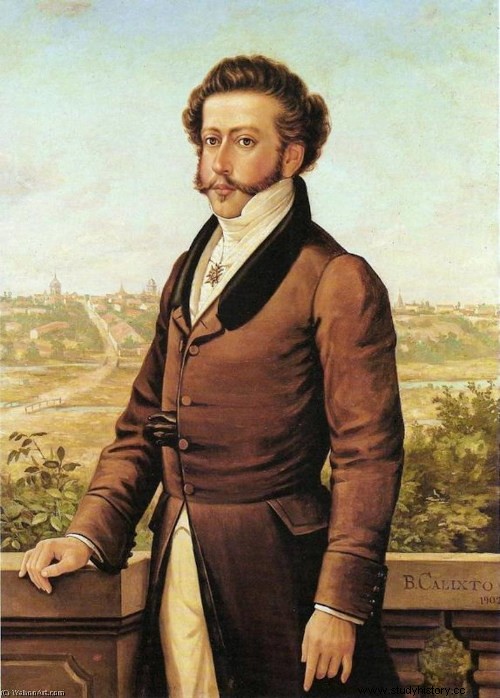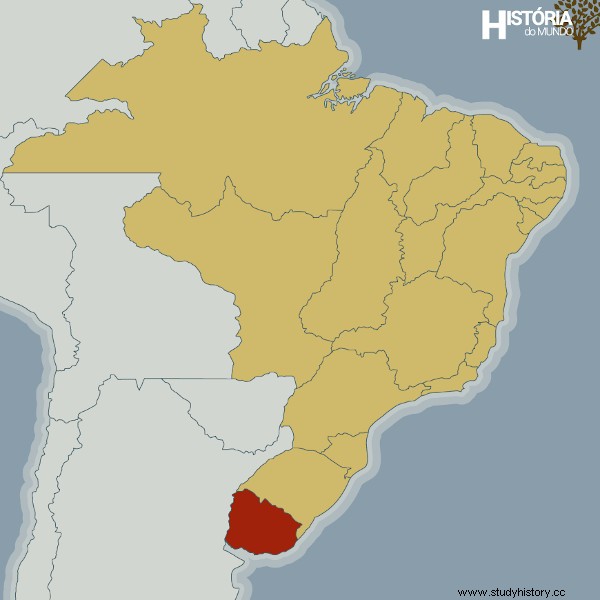
The Cisplatin War was a conflict that took place between 1825 and 1828 involving the Empire of Brazil and the United Provinces of Rio da Prata, which disputed the Province of Cisplatina. The region belonged to Brazil since 1808, when Dom João VI and the Portuguese royal family landed in the colony. The war began in 1825, during the reign of Dom Pedro I, and ended with the defeat of Brazilian troops and the loss of Cisplatina, which became the Oriental Republic of Uruguay.
Also know: How did Spanish America gain independence in the 19th century?
Summary on the Cisplatine War
-
The Cisplatina War was a battle between the Empire of Brazil and the United Provinces of Rio de la Plata for the Province of Cisplatina, between 1825 and 1828.
-
The war was caused due to the territorial dispute between Brazilians and Cisplatinos.
-
Brazilian troops did not receive the necessary investments to defeat the enemies during the war.
-
Brazil lost the war and the Province of Cisplatina, which became Uruguay.
-
The war caused a serious economic crisis for the First Reign in Brazil and the unpopularity of Dom Pedro I.
Video Lesson on the Cisplatine War
Causes of the Cisplatin War
The causes of the Cisplatine War date back to the colonial period. During this period, P Portugal and Spain disputed the limits of their domains in the Rio de la Plata region . It is important to note that:
-
In 1680, the Portuguese built a fort on the east bank of the river, giving rise to the Colonia de Sacramento.
-
This fortification was claimed by the Spanish in 1977.
-
Several treaties, such as the Treaty of Madrid, in 1750, and the Treaty of Idelfonso, in 1777, sought to appease the spirits of the Iberian kingdoms regarding the dispute over the region.
Territorial competition was not the only cause of rivalry between Portugal and Spain in the Rio de la Plata region. In 1808, the French Emperor Napoleon Bonaparte ordered theinvasion of the Portuguese kingdom, because this one did not adhere to Continental Blockade , which determined that the countries of the European continent were prohibited from trading with England and from receiving her ships. The Prince Regent chose to maintain commercial relations with England.
Napoleon sent his troops to Portugal, and the Spaniards collaborated with the French , ceding their territory for the passage of the Napoleonic army. Dom João VI, together with the Portuguese royal family, fled to Brazil before the arrival of French soldiers.
Disembarking on Brazilian soil, thePortuguese prince decided to retaliate against the Spaniards for having collaborated with the movement of French troops, which culminated in the invasion of the kingdom of Portugal. Dom João VI ordered, in 1816, that his army occupied Cisplatina and annexed the territory to the domain of Portugal.

With Brazilian independence, in 1822, the province made part of Brazil. However, this political change did not appease the spirits of the Cisplatines. In 1826, Juan Antonio Lavalleja, military and politician, led a revolt, as the Cisplatines wanted your territory was appended the to s Province s United s Rio de la Plata (now Argentina). To justify the annexation, that province sent military and financial support to the revolt led by Lavalleja.
What are the goals of the countries involved in the Cisplatin War?
The various sides involved in the Cisplatine War had different goals.
-
Brazilian Empire
For the Empire of Brazil, was paramount keep the territo orium and avoid any kind of revolt that promoted the separation of some province. When Juan Antonio Lavalleja started the Cisplatina rebellion in 1826, Dom Pedro I, the first emperor of Brazil, immediately sent troops to quell the rebel movement.
In addition to the desire to maintain territorial unity, provincial insurrections could motivate other Brazilian regions to also organize uprisings against the central government, which was not in the emperor's interest.
-
Groups against the Brazilian domain
Among the groups opposed to Brazilian rule, there were diffuse objectives regarding the conflict.
-
Juan Antonio Lavalleja: wished to annex Cisplatina to the United Provinces of the Rio de la Plata.
-
Other groups also dissatisfied: they wanted independence for the province and for it to become a new republic in South America.
Main Battles of the Cisplatine War
Dom Pedro I did not hesitate to send troops to Cisplatina and defeat the insurgents led by Lavalleja. The Brazilian army was truculent and spared no effort to massacre its enemies. The arbitrary form of action of the Brazilian soldiers provoked a negative reaction from the local population.
In the early years of the First Reign, Brazil faced a serious economic crisis and there was not enough investment to arm and train soldiers , which facilitated the action of the Cisplatine troops and the Brazilian defeat in the war.
As the war took place in wetlands and rivers, the navy's role was important. Brazil faced difficulties in training its sailors, due to the lack of personnel. Both Brazilians and Cisplatines hired mercenaries to act in the confrontation, but the result was negative.
At first, Brazilian troops blocked Buenos Aires. However, the shallow waters of the rivers in the region prevented the movement of vessels from Brazil. The Cisplatines tried to break the blockade and invade the territory of Rio Grande do Sul.
The problems that Brazil faced in the war were not only related to military issues. Dom Pedro I faced political problems, as the parliamentary s avoided sending military aid to the conflict region, weakening the army and navy. The emperor himself traveled to the south of Brazil to closely follow the fights against the enemies.
He landed on December 7, 1826 in Rio Grande do Sul and found the Brazilian military demoralized and without resources to continue the war. The emperor ordered the dismissal of officers and tried to reorganize the troops. However, the death of Empress Leopoldina, in 1827, made him return to Rio de Janeiro.
The main battles of the Cisplatine War were:
-
Battle of Sarandi: occurred on October 12, 1825 at Arroio Sarandi, in Uruguay.
-
Battle of the Rosary Step: occurred on February 20, 1827, on the banks of the Santa Maria River, in Rio Grande do Sul.
-
Battle of Juncal: occurred between February 8 and 9, 1827, on Juncal Island, on the Uruguay River.
See also: Guerra dos Farrapos — separatist conflict that took place in Rio Grande do Sul in 1835
Who won the Cisplatinum War?
The high cost of the conflict for the participants of the Cisplatine War, as well as the military precariousness of those involved, made England encourage the end of the battle. Peace was negotiated under the mediation of the French and English. Thepeace treaty, disastrous for the country , was signed on August 28, 1828.
In addition to the territorial loss, the financial loss was 30 million dollars and 8 thousand Brazilians killed. Cisplatina obtained its independence and became the Oriental Republic of Uruguay. It can be said that the Brazilians were the great losers of the war, while the Cisplatines were the winners .
Consequences of the Cisplatin War
The main consequence of the Cisplatine War was the dismemberment of the province from Brazilian territory . From then on, the Oriental Republic of Uruguay was formed. Also, the war:
-
increased Dom Pedro's unpopularity;
-
deepened the economic crisis experienced by the Brazilian Empire in its early years;
-
contributed to the crisis of the First Reign, which led Dom Pedro I to abdicate the Brazilian throne in 1831.
Resolved exercises on the Cisplatine War
Question 1
The Cisplatine War (1825–1828) had as its main consequence:
a) the independence of Argentina, which turned into an empire.
b) the formation of the Oriental Republic of Uruguay.
c) the end of the Brazilian empire and the Proclamation of the Republic.
d) creation of the Bolivian Republic.
Resolution:
Alternative B
With the end of the Cisplatine War, the province, which belonged to Brazil, became independent, giving rise to the Oriental Republic of Uruguay.
Question 2
Check the alternative that shows why the image of Dom Pedro I was worn during the Cisplatine War.
a) The Portuguese support received by the Emperor during his rule.
b) Dom Pedro I's indecision to act against the revolt in Cisplatina.
c) Dom Pedro I's threat to renounce the Brazilian throne.
d) The increase in taxes and the loss of the province of Cisplatina.
Resolution:
Alternative D
Dom Pedro I left the Cisplatine War with his image worn out because of the economic crisis that raised taxes and the loss of territory after the end of the conflict.
